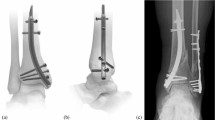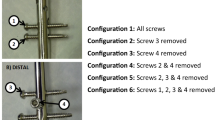Abstract
Objectives
To determine whether there are differences in stability between double and triple interlocked intramedullary nails used for the fixation of extraarticular proximal tibial fractures.
Design
Randomized in vitro biomechanical-experimental laboratory investigation.
Setting
Biomechanics laboratory of the Clinic for Trauma Surgery at the Johannes Gutenberg-University Mainz.
Intervention
A 10-mm defect osteotomy was performed on six paired human tibiae, and the proximal and distal ends were potted in polymethylmethacrylate cement (PMMA). Each pair of bones was randomly stabilized with an intramedullary nail (IM-nail) with two interlocking options (PTN 2s) in one tibia, and with an IM-nail with three interlocking options (PTN 3s) in the corresponding contralateral bone. A biomechanical test of the bone implant construct was then performed with an axial force of 900 N. Displacement of bone fragments was measured and depicted as a force–displacement diagram.
Main outcome measurements
Biomechanical construction stiffness.
Results
The stiffness values for PTN 3s were significantly higher than for PTN 2s. In the group of PTN 2s, two out of six implants failed biomechanically with breakage of one proximal interlocking screw.
Conclusions
Given the parameters of this investigation, triple proximal interlocking provides more stability in nailed proximal tibia fractures than double proximal interlocking. Larger series with clinical follow-up after triple proximal interlocking in tibial nailing should be undertaken to further clarify these questions.


Similar content being viewed by others
References
Bolhofner BR (1995) Indirect reduction and composite fixation of extraarticular proximal tibia fractures. Clin Orthop 315:75–83h
Buehler KC, Green J, Woll TS, Duwelius PJ (1997) A technique for intramedullary nailing of proximal third tibia fractures. J Orthop Trauma 11:218–223
Cole JD (1998) Intramedullary fixation of proximal tibia fractures. Techniques in Orthop 13:27–37
Dendrinos GK, Kontos S, Katsenis D, Dalas A (1996) Treatment of high-energy tibial plateau fractures by the Ilizarov circular fixator. J Bone Joint Surg (Br.) 78:710–717
Duda G, Mandruzzato F, Heller M et al (2002) Mechanical conditions in the internal stabilization of proximal tibial defects. Clin Biomech (Bristol, Avon) 17:64–72
Freedman EL, Johnson EE (1995) Radiographic analysis of tibia fracture malalignment following intramedullary nailing. Clin Orthop 315:25–33
Gerber A, Ganz R (1998) Combined internal and external osteosynthesis. A biological approach to the treatment of complex fractures of the proximal tibia. Injury 29(Suppl 3):22–28
Hansen M, Blum J, Mehler D, Rommens PM (2002) Intramedullary osteosynthesis of metadiaphyseal proximal tibial fractures: an optimized implant geometry can help to solve the problem. Osteosynth Trauma Care 10:188–191
Hansen M, Mehler D, Voltmer W, Rommens PM (2002) The extraarticular proximal tibial fracture. Unfallchirurg 105:858–873 (in German)
Hansen M, Mehler D, Hessmann MH, Blum J, Rommens PM (2007) Intramedullary stabilization of extraarticular proximal tibial fractures: a biomechanical comparison of intramedullary and extramedullary implants including a new Proximal Tibial Nail (PTN). J Orthop Trauma 10:701–709
Krettek C, Miclau T, Schandelmeier P, Stephan C, Moehlmann U, Tscherne H (1999) The mechanical effect of blocking screws (“Poller screws”) in stabilising tibia fractures with short proximal or distal fragments after insertion of small diameter intramedullary nails. J Orthop Trauma 13:550–553
Laflamme GY, Heimlich D, Stephen D, Kreder HJ, Whyne CM (2003) Proximal tibial fracture stability with intramedullary nail fixation using oblique interlocking screws. J Orthop Trauma 17:496–502
Lang GJ, Cohen BE, Bosse MJ, Kellam JF (1995) Proximal third tibia fractures—should they be nailed? Clin Orthop 315:64–74
Marsh JL, Smith ST, Do TT (1995) External fixation and limited internal fixation for complex fractures of the tibial plateau. J Bone Joint Surg (Am) 77:661–673
Mueller ME, Allgoewer M, Schneider R, Willenegger H (1992) Manual der Osteosynthese. AO-Technik. Springer Verlag, Berlin-Heidelberg-New York
Mueller CA, Eingartner C, Schreitmueller E et al (2005) Primary stability of various forms of osteosynthesis in the treatment of the proximal tibia. J Bone Joint Surg (Br.) 87:426–432
Ricci WH, O`Boyle M, Borrelli J, Bellabarbara C, Sanders R (2001) Fractures of the proximal third of the tibial shaft treated with intramedullary nails and blocking screws. J Orthop Trauma 15:264–270
Rommens PM (1992) The significance of soft tissue trauma for fracture healing: a prospective study of 70 tibial shaft fractures. Acta Chir Belg 92:10–18
Schandelmeier P, Krettek C, Rudolf J, Kohl A, Katz BE, Tscherne H (1997) Superior results of tibial rodding versus external fixation in grade 3B fractures. Clin Orthop 342:164–172
Conflict of interest statement
No benefits in any form have been received or will be received from any commercial party related directly or indirectly to the subject of this manuscript.
Author information
Authors and Affiliations
Corresponding author
Additional information
The implants were delivered by STRATEC Medical (Oberdorf, Switzerland). The Proximal Tibial Nail (PTN) used in this investigation is not FDA approved.
Rights and permissions
About this article
Cite this article
Hansen, M., Blum, J., Mehler, D. et al. Double or triple interlocking when nailing proximal tibial fractures? A biomechanical investigation. Arch Orthop Trauma Surg 129, 1715–1719 (2009). https://doi.org/10.1007/s00402-009-0954-1
Received:
Published:
Issue Date:
DOI: https://doi.org/10.1007/s00402-009-0954-1




